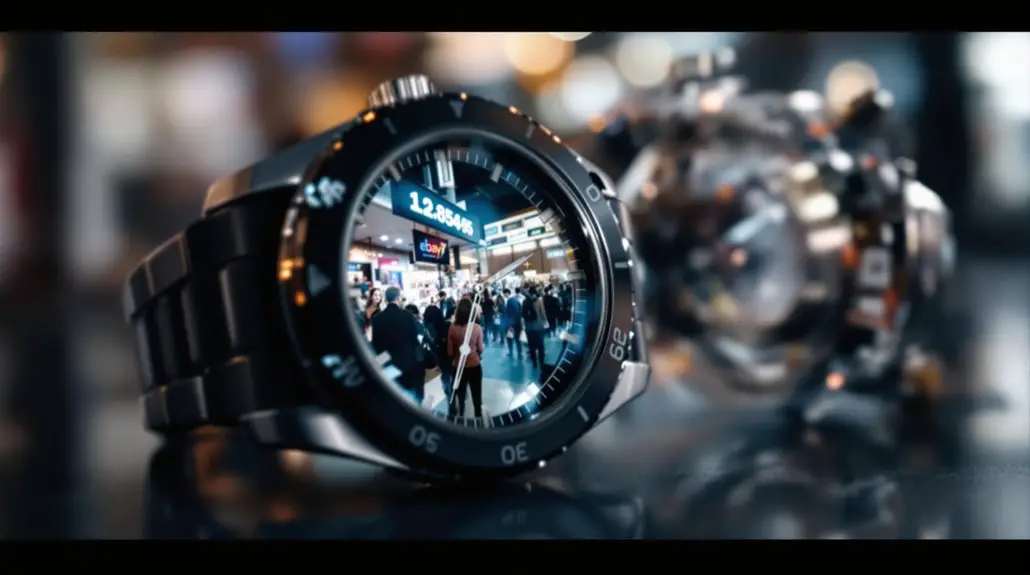Imagine this: you're scrolling through eBay, and suddenly, a price ending in .99 grabs your eye, whispering sweet nothings about a deal so good, it's almost scandalous. That's charm pricing at work, playing on your eyesight to trick your wallet. Or perhaps you've felt the pull of a seemingly pricier item right next to the one you're considering, making the latter look reasonable in comparison—voila, decoy pricing. These tactics are like Harry Potter's invisibility cloak for smart sellers, allowing their items to seem irresistibly attractive. By understanding how these strategies manipulate your buying decisions, you're not just browsing, you're setting off on a psychological adventure.
Understanding Psychological Pricing
Understanding Psychological Pricing means recognizing how subtle pricing strategies influence your buying decisions, leading to higher sales for sellers.
When you're browsing eBay, have you ever noticed how prices often end in .99? That's because sellers understand charm pricing, a technique that makes $2.99 seem way less than $3, thanks to our brain's *left-digit effect*. You see the number "2" and feel like you're getting a bargain. It's clever, right? Odd/even pricing involves odd numbers to tempt your budget consciousness, making you think items are cheaper. For instance, $19.99 looks much smaller than $20. Moreover, sellers on platforms like Vinted benefit from no selling fees, allowing them to price their items competitively without financial penalties. In the classic Nike Apparel Resale Catalogue, significant price changes indicate that sellers leverage psychological pricing strategies to heighten consumer interest. Additionally, prices in the resale market often vary based on an item's condition and size, further enhancing the perceived value.
Price anchoring plays on your perceptions, showing you a high "original" price, followed by the *discounted* price, nudging you to believe you're getting a steal. This makes the second price seem more attractive. Imagine you spot a watch. The first one's at $200, but hey look, another's at $150. Suddenly $150 feels like a find! Additionally, the flat-rate bias can also influence your perception of value; buyers prefer the simplicity and predictability of flat rate pricing, which can make offers seem more appealing on eBay.
eBay sellers aren't just listing prices; they're crafting perceptions, leading you, almost unknowingly, to their irresistible "value" sales. Isn't that quite the clever ploy sellers use to charm you into buying?
Exploiting Cognitive Biases
When you're scanning eBay's listings, don't be surprised if you feel influenced by sellers' clever tactics.
They've got a knack for making your heart beat faster and your wallet lighter. Here are a few tricks they play:
- Price Anchoring- You've seen it all the time: a high initial price only to be slashed during a "sale." That's sellers setting an anchor, making the lower price look like a sweetheart deal. Sales Performance shows that effective pricing contributions can potentially lead to quicker sales, especially in the case of items like size M that command higher price points.
- Left-Digit Bias- Ever wonder why everything's priced at $9.99? That's charm pricing for you. Your brain sees a price starting with nine, not ten, fooling you into thinking it's cheaper than it is. It's like magic in numbers.
- Social Proof- When you see that badge shouting "Most Popular!" or "Best Seller," your interest peaks. It's not just peer pressure, it's a trust booster, making you lean towards a product because well, Monica from Ohio did.
These aren't just pricing strategies; they're psychological chess moves, and you're part of the game every time you shop on eBay.
Implementing Pricing Strategies
To optimize your eBay sales, you'll need to plunge into Implementing Pricing Strategies. Here's how you can do it:
| Strategy | Example |
|---|---|
| Charge Pricing | Price at $19.99 instead of $20, leveraging the left-digit bias. |
| Decoy Pricing | Offer a higher-priced item to make the main product appear cheaper by comparison. |
| Automated Pricing | Use Scarcity Manager to instantly adjust your prices based on market changes. Automated repricing tools like Scarcity Manager help improve visibility in eBay's Buy It Now Box. |
| Market Research | Regularly check competitor's prices to fine-tune your strategy. |
You can make your prices seem reasonable by setting a higher anchor. Let's say you have a $50 shirt; show it at $75 first, then drop it to an 'as new' status for $50. You've created an illusion of value! Additionally, utilizing significant markdowns can enhance consumer interest and promote quicker sales. Robust resale values for popular brands like Stone Island can also guide your pricing based on competitive resale trends. Use apps like Scarcity Manager to match your product's listing price with how much people are biting. Trust me, it's like riding a roller coaster — every dip and rise in the market is essential! Remember, it's not just about undercutting everyone; it's about being smart with your prices. Keep tabs on competitors to dance in the beat of the market. Always measure your dance moves — your promotions and their effectiveness. Adjust, adjust, adjust!
Comparative Pricing Techniques
Diving into Comparative Pricing Techniques, you'll need to keep a sharp eye on what your competitors are up to on eBay. You can't just wing it when setting your prices; it's like a chess game, every move counts.
You've got to play smart:
- Monitor Competitor Prices: Set up those price trackers, and dive deep into eBay's data. It's like going on a treasure hunt, but instead of gold, you're searching for that sweet spot where your price can shine.
- eBay's Pricing Tool: Use eBay's own tools to get a leg up. The "Sold items" feature? Gold mine. It'll show you what's actually getting sold, helping you price not just to compete, but to win.
- Competitively Analyze Listings: Live through these listings. View the sold ones, sift through the similar ones, and learn from what's been done before.
It's your roadmap to maintaining your price point where buyers are biting.
Urgency and Scarcity Tactics
Don't just focus on what your competitors are listing; let's use urgency and scarcity to turbocharge your sales on eBay.
Envision your listings like holiday weekend sales or a one-day flash sale. You've got time-sensitive discounts that spark excitement. When customers see countdown timers, it's like a ticking clock, urging them to act before it's too late.
Now, think about limiting quantities. Visualize this: exclusive VIP deals for those favorite return buyers of yours or listings like, "Only a few left," that fuel that competitive spirit.
Imagine those limited-edition items like a blockbuster hitting only a few theaters. And here's a secret: play your cards right with scarcity, show that stock's low, and watch the demand soar, like the last slices of a pizza everyone wants.
And let's not forget, when folks are about to leave your page, a little exit pops up, 'Buy now or miss out!'





????????? Nautilus, ????????? ???????? ??????? ????????? ??????, ???????? ?????????? ??? ? ?????????? ????????????????. ?????? Nautilus 5711 ? ??????????????? ?????????? ????? ??????????????????? ?? 2 ???? ? ?????? ?? ?????? ??????.
?????????????? ?????? ? ????????? ??????? ? ????????? ? ?????????? ?? ?????? ? ??????? ???????????? ?????????????? ??????. ??????? ? ???????????????? ???????? ???????????? ??????? ??????? ???? ??? ???????? ?????? ?????.
???? ???????? ?????????? ????? ? ??????? 3 ???? ? ?????????? ???????.
??? ??????? ??????????? ???????? ??????????, ???????? ? ????????? ??????? ???????? ?????.
https://patek-philippe-nautilus.ru/
????????, ?????? 5712/1R-001 ?? ???????? ?????? 18K ? ???????? ?????????? ????????? ? ??????? ???? ?? ???? ?????.
Nautilus ???????? ???????? ???????, ????????? ????????? ? ???????? ???????????? ???????? ????.
????? ???????? ??????????-??? “???? ????”, ??? ????? ?????? ?? ???????? ?? ????????? ??????.
?????? ??????? ???? ?? ???, ??????????? ????????? ????????? ? ??????. ? ??? ??????? ?????????????? 5 ?????????? ???????? ? ????????? ?????? ?? ????.
?????????? ???????? ???????? ????????? ?????? ? ???????????? ?????-?????????. ???? ???? ??????????? ????????? ???????? ? ???????? ????? ? ????????? ???????? ? ?????? ????????? ???????.
???? ???? ???
??? ??? — ????? ? ??????? ????? ????????.
???? ??? ??????? ???????? ?????????? ?? ????????? ???????.
?????????? ?????? ???, ??????? , ????? ???????? ???????? .
??? ????????? ????????? ?????? ? ???????? ?????.
?? ????? ???? ????
?????????? ??????????? ????????? ? ????????? ????????????? .
???????? ???????? ??? ???????? ????????? ????? ??????????????? .
??????????? ? ???????????? ?????????? — ?????????????.
?????? ????? ?????????? ? ???????? ? ??? ?????? ??????? ????????? ????? ? ?????? ????????? ??????? .
??????????? ?????????? ????????? ??? ??????? ???????? ?????? ? ???????? ??????????.
???????? ????? ?????? ??? ???????? ????? ?????????????????? ???? ? ????????? ???????? .
????????? ???? ????
??? ???????? ? ??????????? GDPR, ????????? ?????? ???????? ?????? .
???????? ???????????????? ??????? ? ??????????????? ??????? ? ????????? ?????????? .
?????????? ????????? ????????? ??? digital-????????????? — ?????????? ??? ?????? !
I used to think healthcare worked like clockwork. Doctors give you pills — you don’t question the process. It felt safe. Eventually, it didn’t feel right.
Then the strange fog. I blamed stress. But my body was whispering something else. I searched forums. The warnings were there — just buried in jargon.
tadapox flashback
It finally hit me: your body isn’t a template. Two people can take the same pill and walk away with different futures. Side effects hide. And still we keep swallowing.
Now I pay attention. But because no one knows my body better than I do. I track everything. It makes appointments awkward. This is self-respect, not defiance. And if I had to name the one thing, it would be keyword.